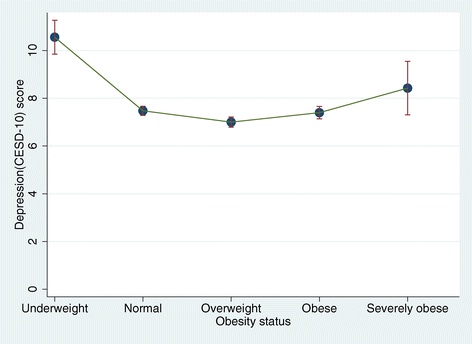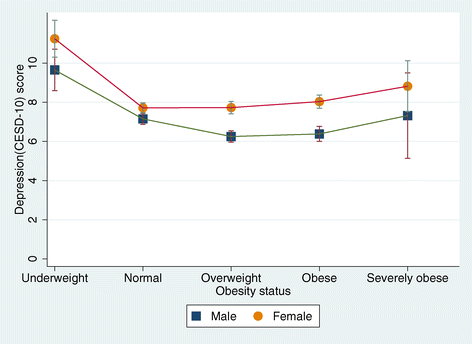Body mass index and depressive symptoms in middle aged and older adults
- PMID: 25884564
- PMCID: PMC4383216
- DOI: 10.1186/s12889-015-1663-z
Body mass index and depressive symptoms in middle aged and older adults
Abstract
Background: The relationship between weight problems and depression has been the focus of many studies; however, results from these studies vary. The purpose of this study is to describe the association between depression and BMI using data from a national sample of middle aged and older Koreans and to examine whether gender moderates the relationship between depression and weight.
Methods: We used data from the Korean Longitudinal Study of Aging (KLoSA). Of the 7,920 respondents that participated in KLoSA in 2010, 7,672 adults aged between 50 and 102 years were included in the final analysis. The relationship between depression and obesity status was examined in both the full sample and in sub-samples stratified by gender. The observed U-shaped association between obesity status and CES-D score was tested by regressing CES-D score on linear and quadratic terms of BMI scores.
Results: The distribution of CES-D scores by respondents' obesity status (i.e., underweight, normal weight, overweight, obese and severely obese) showed a U-shaped association. Specifically, the highest CES-D scores were found in underweight individuals; this was followed by the severely obese and obese groups in the full sample and in gender-specific subsamples. The lowest CES-D scores were found in the overweight group when considering the entire population and males alone and in the normal weight group for females. This U-shaped association between CES-D and obesity status was confirmed by a model in which CES-D scores were regressed on BMI scores and other covariates.
Conclusions: This study found a U-shaped association between BMI and levels of depressive symptoms among adults in Korea overall and also within each gender. Specifically, the highest level of depressive symptoms was found among the underweight, followed by the severely obese and then the obese. Slightly different patterns between male and female adults were found regarding the weight status associated with the fewest depressive symptoms.
Figures
Similar articles
-
Negative association between BMI and depressive symptoms in middle aged and elderly Chinese: Results from a national household survey.Psychiatry Res. 2018 Nov;269:571-578. doi: 10.1016/j.psychres.2018.08.107. Epub 2018 Aug 31. Psychiatry Res. 2018. PMID: 30199699
-
U-shaped relationship between depression and body mass index in the Korean adults.Eur Psychiatry. 2017 Sep;45:72-80. doi: 10.1016/j.eurpsy.2017.05.025. Epub 2017 Jun 3. Eur Psychiatry. 2017. PMID: 28738292
-
Obesity and the onset of depressive symptoms among middle-aged and older adults in China: evidence from the CHARLS.BMC Public Health. 2018 Jul 24;18(1):909. doi: 10.1186/s12889-018-5834-6. BMC Public Health. 2018. PMID: 30041632 Free PMC article.
-
[Study on the relationship between mental health and overweight, obesity, different sex among junior middle school students].Zhonghua Liu Xing Bing Xue Za Zhi. 2007 May;28(5):460-3. Zhonghua Liu Xing Bing Xue Za Zhi. 2007. PMID: 17877175 Chinese.
-
Depression and peripheral inflammatory profile of patients with obesity.Psychoneuroendocrinology. 2018 May;91:132-141. doi: 10.1016/j.psyneuen.2018.03.005. Epub 2018 Mar 9. Psychoneuroendocrinology. 2018. PMID: 29550676 Review.
Cited by
-
Association of Body Mass Index with Suicide Behaviors, Perceived Stress, and Life Dissatisfaction in the Korean General Population.Psychiatry Investig. 2018 Mar;15(3):272-278. doi: 10.30773/pi.2017.06.28. Epub 2018 Feb 28. Psychiatry Investig. 2018. PMID: 29486542 Free PMC article.
-
Weight Status, Physical Activity, and Depression in Korean Older Adults.J Epidemiol. 2018 Jun 5;28(6):292-299. doi: 10.2188/jea.JE20170083. Epub 2018 Jan 20. J Epidemiol. 2018. PMID: 29353866 Free PMC article.
-
Chronic exercise effects on overall depression severity and distinct depressive symptoms in older adults: A protocol of a systematic and meta-analytic review.PLoS One. 2024 May 23;19(5):e0297348. doi: 10.1371/journal.pone.0297348. eCollection 2024. PLoS One. 2024. PMID: 38781250 Free PMC article.
-
Physical Health Among Adults with Depressive Symptoms in Qatar: Findings from Qatar Biobank Population-Based Study.Int J Environ Res Public Health. 2025 May 2;22(5):726. doi: 10.3390/ijerph22050726. Int J Environ Res Public Health. 2025. PMID: 40427842 Free PMC article.
-
Changes in Physical Activity and Depressive Symptoms During COVID-19 Lockdown: United States Adult Age Groups.Front Psychol. 2022 Feb 17;13:769930. doi: 10.3389/fpsyg.2022.769930. eCollection 2022. Front Psychol. 2022. PMID: 35250713 Free PMC article.
References
-
- World Health Organization. Depression: a global public health concem. 2012. Available: http://www.who.int/mental_health/management/depression/who_paper_depress....
-
- World Health Organization. Obesity and overweight. 2013. Available: http://www.who.int/mediacentre/factsheets/fs311/en/.
Publication types
MeSH terms
LinkOut - more resources
Full Text Sources
Other Literature Sources
Medical



